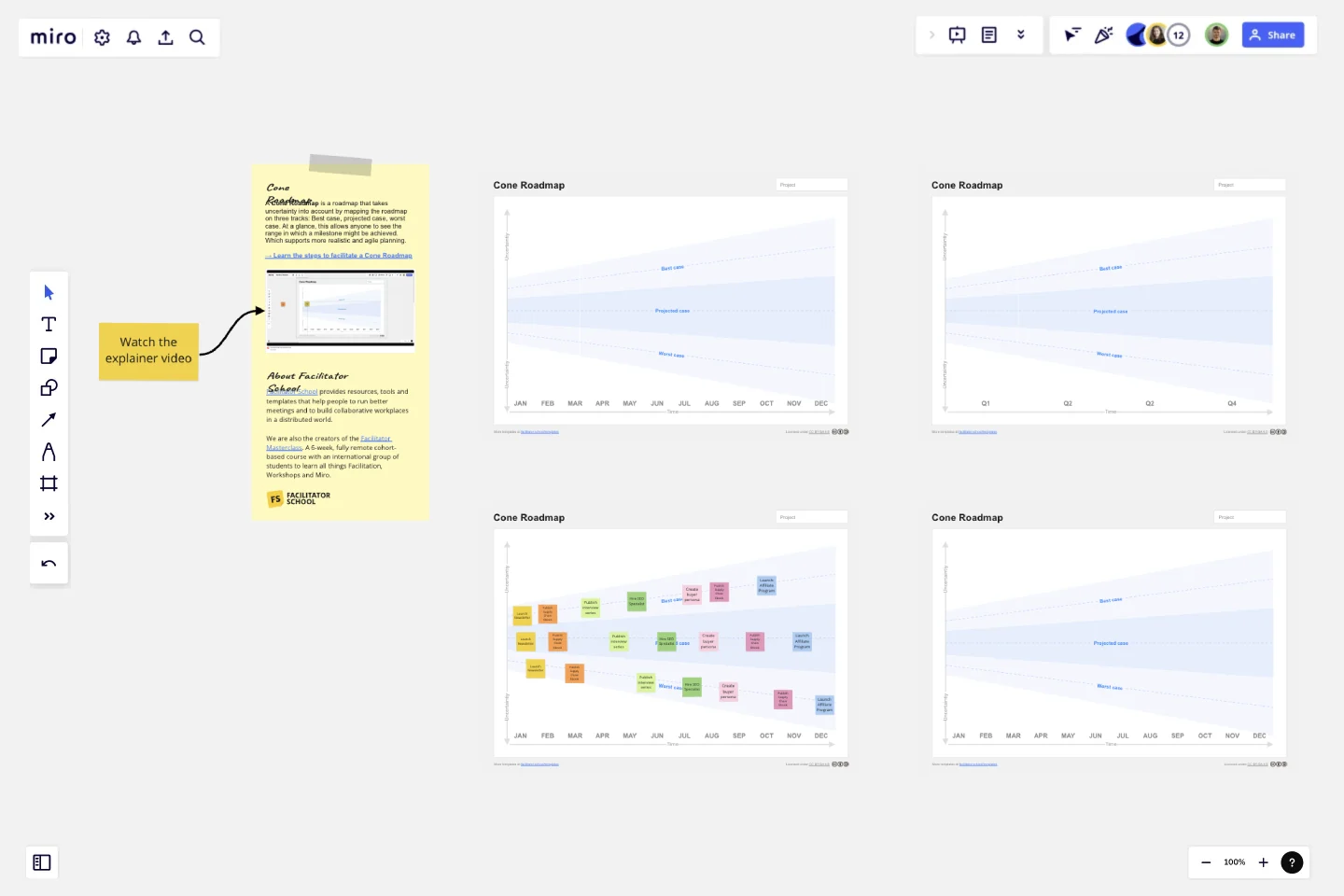Cone Roadmap
A Cone Roadmap is a roadmap that takes uncertainty into account by mapping the roadmap on three tracks: Best case, projected case, worst case. At a glance, this allows anyone to see the range in which a milestone might be achieved. Which supports more realistic and agile planning.
How does the Cone Roadmap work?
Step 1: Map out the best case
Ask yourself "How would the roadmap look like, when everything goes well?". Given your answer, add the milestones to the top track that represents the best case for the roadmap. Where you place the milestones should be optimistic, but at the same time realistic and achievable.
Step 2: Map out the worst case
Ask yourself "How would the roadmap look like, when everything goes wrong?". Especially think about how long it might take to achieve a milestone. Now duplicate and place the same milestones on the bottom track to represent the worst case scenario.
Step 3: Map out the projected case
Given the best and worst case of the roadmap, you can now see a range for when each milestone might be achieved. As the last step, duplicate each milestone one last time and place it in the middle of the range. When you are done with all milestones, this creates an average between the two extremes and gives you the projected case.
This template was created by Facilitator School.
Get started with this template right now.
Outcome Mapping Template
Works best for:
Diagrams, Mapping, Project Management
Use Miro’s outcome mapping template to improve your operational efficiency. Outcome mapping will help you visualize all the possible strategic outcomes for your upcoming project, allowing you to see into the black box to identify any potential challenges along the way.
Strategy Map Template
Works best for:
Leadership, Strategic Planning, Mapping
How do your individual or team goals relate to an organization’s overall strategy? A Strategy Map is a stylized picture of your organization’s strategy and objectives. It’s powerful because it provides a clear visual guide to how these various elements work together. Strategy Maps can help align various different team goals with the overall strategy and mission. With the Strategy Map in place, teams can create set actionable, relevant KPIs. Strategy mapping is often considered part of the balanced scorecard (BSC) methodology, which is a strategic planning tool for setting overall team goals.
The Product Hunt
Works best for:
Product Management, Planning
The Product Hunt template provides a platform for collecting and prioritizing product ideas. By allowing teams to submit, review, and vote on ideas, this template fosters a culture of innovation and collaboration. With features for categorizing ideas, tracking progress, and celebrating successes, it promotes transparency and engagement across teams. This template serves as a central hub for capturing and nurturing innovative ideas, driving continuous improvement and product innovation.
Simple Quarterly Product Roadmap
Works best for:
Roadmap, Planning, Mapping
Plan your product development with the Quarterly Product Roadmap template. This tool helps you outline key objectives and tasks for each quarter. Use it to set clear priorities, align your team, and track progress over time. Ideal for product managers and teams aiming to maintain focus and achieve quarterly goals. Simplify your planning process and ensure everyone is on the same page with this easy-to-use roadmap template.
Service Blueprinting Workshop
Works best for:
Agile
The Service Blueprinting Workshop template helps teams visualize and improve service processes. It includes ice breakers, context canvas, empathy maps, and action plans for service transitions. Use it to align teams, identify opportunities, and prototype service delivery from a macro to microscopic level, ensuring a comprehensive understanding of service orchestration and seamless collaboration. Ideal for remote and dispersed teams.
Sustainable Product Innovation Board
Works best for:
Product Management, Planning
The Sustainable Product Innovation Board template supports sustainable product development practices. By integrating sustainability criteria into product ideation, design, and implementation processes, this template fosters eco-friendly product innovation. With sections for evaluating environmental impacts and setting sustainability goals, it enables teams to create products that minimize ecological footprints and promote social responsibility. This template serves as a framework for driving sustainable business practices and meeting consumer demands for environmentally conscious products.
